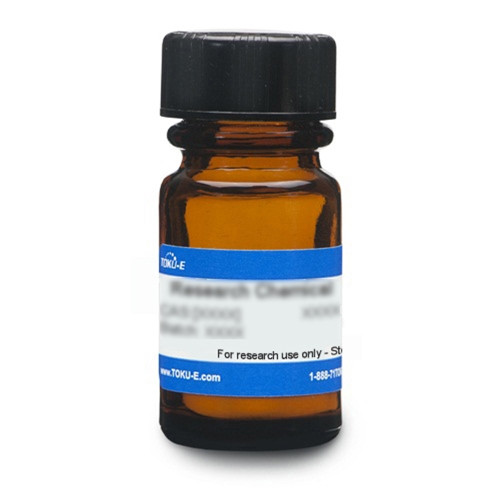Pirlimycin Hydrochloride is the hydrochloride salt form of Pirlimycin, a semi-synthetic tetracycline analog and derivative of clindamycin, a broad-spectrum antibiotic belonging to the lincosamide class, which has activity against anaerobes. The hydrochloride salt forms at the basic pipercolic acid moiety. This product is derived from a single fraction and offers molecular homogeneity. The compound is used in veterinary research against the bacteria that cause mastitis in cattle. It can be used in food testing applications for detection of the presence of the marker residue Pirlimycin.
Pirlimycin Hydrochloride is soluble in water.
We also offer:
| Molecular Formula | C17H31ClN2O5S • HCl |
| Spectrum | Pirlimycin Hydrochloride is active against Gram-positive bacteria including Staphylococcus, Streptococcus, Bacterioides, and Plasmodium. It is also active against anaerobic bacteria and protozoa. |
| Mechanism of Action | Pirlimycin inhbits bacterial protein synthesis by binding to the 50S ribosomal subunit and thereby inihibiting peptidyl transferase. Specifically, Pirlimycin binds to the peptidyl transferase center within the 50S subunit. |
| Microbiology Applications |
In vitro activity of Pirlimycin Hydrochloride and its primary metabolite, Pirlimycin sulfoxide, was investigated. Lowest MIC50 was observed in Bifidobacterium spp. and Eubacterium spp. (0.06 µg/ml). Pirlimycin sulfoxide was less active, with lowest MIC50 of 1 µg/ml in Eubacterium spp. Therefore, the parent compound showed a 16-fold higher antimicrobial activity comparied to Pirlimycin Sulfoxide. Pirlimycin Hydrochloride is the active component of Pirsue, an aqueous gel given via intramammary infusion to treat mastitis in lactating dairy cattle. Microbiological investigation can be evaluated for the antimicrobial effectiveness against different groups of bacteria. Several studies have found in vitro resistance to Pirlimycin. Parent Pirlimycin is the only significantly microbiologically active residue in tissue and milk samples, and methods detect residues both qualitatively and quantitatively. In addition to a microbiological assay, a high specific HPLC/TSP/MS method is available to measure residues in tissue and milk. ELISA-based detection for food safety protocols have been developed for beef, milk, and honey samples. Pirlimycin is the marker residue in milk. Pirlimycin residues in milk, egg, beef and honey was detected via a gold immunochromatographic strip. This strip simultaneously detected Pirlimycin, clinamycin and lincomycin simultaneously with a single monoclonal antibody and quantified with a handheld strip scanner for rapid on-site screening (Guo et al, 2019). |
| Mechanism of Action |
Pirlimycin binds to the 23S ribosomal subunit, blocking protein synthesis. |
| References |
Ahonkhai VI et al (1982) In vitro activity of U-57930E, a new Clindamycin analog, against aerobic Gram-positive bacteria. Antimicrob. Agents Chemother. 21:902 Birkenmeyer RD et al (1984) Synthesis and antimicrobial activity of Clindamycin analogs: Pirlimycin, 1,2 a potent antibacterial agent. Med. Chem. 27:216 Feng X, Chambers LR and Knowlton KF (2020) Antibiotic resistance genes in the faeces of dairy cows following short-term therapeutic and prophylactic antibiotic administration. J. Appl. Animal Res. 48(1):34-37 Heller DN (1997) Determination of Pirlimycin residue in milk by liquid chromatographic analysis of the 9-fluorenylmethyl chloroformate derivative. J AOAC Int. 80(5):975-981 PMID 9325575 Hornish RE, Roof RD, Wiest JR (1998) Pirlimycin residue in bovine liver- a case of reverse metabolism. Analyst 123(12):2463-2467 Lindeman CJ et al (2013) Susceptibility to antimicrobial agents among bovine mastitis pathogens isolated from North American dairy cattle. J. Vet. Diagn. Invest. 25(5):581-591 Shah JA, Weber DJ (1984) High-performance liquid chromatographic assay of Pirlimycin in human serum and urine using 9-fluorenylmethylchloroformate. J Chromatogr. 1984 Jul 13;309(1):95-105. doi: 10.1016/0378-4347(84)80009-2. PMID: 6480775 Thornsberry C, Marler JK, Watts JL, Yancey RJ Jr. Activity of Pirlimycin against pathogens from cows with mastitis and recommendations for disk diffusion tests. Antimicrob Agents Chemother. 1993 May;37(5):1122-6. doi: 10.1128/AAC.37.5.1122. PMID: 8517701; PMCID: PMC187914. EMEA/MRL/460/98. Summary Report. Pirlimycin. European Agency for the Evaluation of Medicinal Products, Veterinary Medicines and Information Technology Unit. Committee for Veterinary Products. July 1998 |







